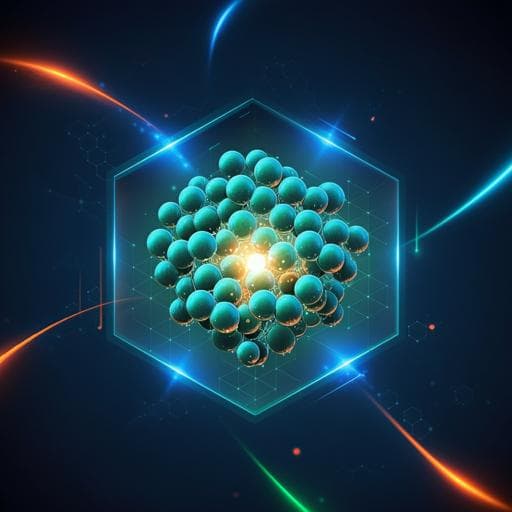
Chemistry
Symmetric carbon tetramers forming spin qubits in hexagonal boron nitride
Z. Benedek, R. Babar, et al.
Investigating symmetric carbon tetramer clusters in hexagonal boron nitride, researchers Zsolt Benedek, Rohit Babar, Ádám Ganyecz, Tibor Szilvási, Örs Legeza, Gergely Barcza, and Viktor Ivády reveal their potential as spin qubits for sensitive sensing applications. The study uncovers unique optical signals and impressive spin properties that promise enhanced detection capabilities.
~3 min • Beginner • English
Introduction
Condensed matter physics in low dimensions is a rapidly growing field, with transition metal dichalcogenides and van der Waals heterostructures driving advances. Nanoscale phenomena demand high spatial resolution sensors operating across wide temperature ranges and sensitive to various fields. Point defect quantum bits (e.g., NV centers in diamond and silicon vacancies in SiC) have demonstrated outstanding capabilities. For high spatial resolution, the sensor’s proximity to the target is crucial, motivating qubits engineered near surfaces or integrated into low-dimensional structures. Existing qubits in 3D semiconductors are not optimal for such applications due to bulk nature and surface chemistry dependence. Layered van der Waals semiconductors may overcome this, as their surfaces are chemically stable and thickness is easily controlled; hBN is a wide-bandgap layered semiconductor often used in such heterostructures and hosts numerous optically active defect states. Single-photon emitters and several ODMR-active centers have been reported in hBN; the negatively charged boron vacancy (V B −) is identified and well-studied, though single-defect PL remains challenging due to low emission rates. Other bright, narrow-line ODMR centers, some linked to carbon, have been observed. Prior theory suggests carbon-related defects can produce similar optical signatures and high-spin states. Here, the neutral nitrogen- and boron-centered symmetric carbon tetramers in hBN, (C B )3−C N (C4N) and (C N )3−C B (C4B), are studied. Their electronic structures comprise a triplet ground state, an optically allowed triplet excited state, and two singlets between the triplets. For C4B, we find large intersystem crossing rates from the triplet excited state to the singlet manifold and a strain-dependent pathway to the ground state. For C4N, spin-selective decay can be enabled by out-of-plane distortions (strain). The weak hyperfine coupling to the environment yields narrow ESR linewidths, enhancing sensitivity. Symmetric C4N and C4B have low formation energies (consistent with Baird aromatic stabilization for even-numbered carbon clusters), suggesting feasible formation under suitable growth conditions.
Literature Review
The paper situates its work within extensive prior research on spin defects for sensing. Established qubits like NV centers in diamond and SiC vacancies have enabled nanoscale sensing but face challenges near surfaces in 3D hosts. hBN, a 2D wide-bandgap material, hosts numerous color centers and ODMR-active defects, including the identified V B − center, which has been thoroughly investigated experimentally and theoretically and used in sensing, though with low single-defect PL rates. Several bright, narrow-line ODMR centers in hBN remain unidentified; experimental evidence ties some ODMR centers to carbon contamination. Theoretical studies have explored carbon clusters and related defects in hBN, identifying candidates with optical properties similar to experiments and some with high-spin ground states. Thermodynamics of carbon defects indicate low formation energies for certain complexes (including tetramers) under N-rich conditions. This motivates investigation of symmetric carbon tetramers C4N and C4B as potential spin qubits.
Methodology
The study combines periodic DFT supercell calculations with quantum chemistry methods on localized models to obtain electronic, optical, and spin properties.
- Periodic supercell DFT: VASP with PAW potentials, plane-wave cutoff 450 eV, HSE06 hybrid functional with 0.32 exact exchange [HSE(0.32)], D3 dispersion correction. Defects modeled in 162-atom monolayer and 768-atom bulk supercells. ZPL energies computed as differences between relaxed ground and excited states obtained by spin-conserving constrained DFT.
- Many-body electronic structure: Active-space multireference calculations at CASSCF-NEVPT2 level for low-energy spectra, singlet and triplet manifolds, and Jahn-Teller effects. Reported adiabatic energy gaps have an anticipated ±0.15 eV error margin.
- Vibrational and optical properties: Transition dipole moments (state-averaged CASSCF-NEVPT2) and harmonic vibrational modes (TD-DFT) used to compute radiative lifetimes, Huang–Rhys factors, Debye–Waller factors, and PL spectra via Golden Rule rate equations. A refractive index of 2.13 and emission wavelength around 590 nm were used for lifetime estimates; line broadening and a small spectral shift were applied to compare with experiment.
- Spin–orbit coupling and intersystem crossing: SOC matrix elements between relevant triplet and singlet states computed (CASSCF-NEVPT2) for equilibrium and symmetry-broken geometries. Strain-induced buckling parameterized by h/R (bubble height/half-width) to assess SOC enhancements. Herzberg–Teller contributions via out-of-plane normal modes considered qualitatively for temperature-dependent ISC.
- Spin properties: Zero-field splitting (D) obtained at CASSCF-NEVPT2 level. Hyperfine tensors computed with periodic hybrid-DFT (bulk model). ESR spectra simulated at B = 0 for different isotope abundances (10B/11B, natural and 13C-enriched).
- Stability: Thermodynamic formation energies and charge transition levels taken from prior work and discussed; additional estimates of kinetic barriers and annealing temperatures for complex formation with interstitial B and C from calculated reaction pathways (details in Supplementary).
Key Findings
- Electronic structure: Both C4N and C4B exhibit triplet ground states (D3h symmetry). For C4N, the optically allowed 3E′ excited state lies 2.32 eV above the 3A2 ground state (ZPL ≈ 2.18 eV after zero-point correction). Two singlets lie between the triplet states at 0.61 eV (1E′) and 1.13 eV (1A1). For C4B, a dark triplet (3A″/JT-lowered 3B2) is at 2.37 eV, and the optically allowed 3E′ is estimated near ~3.0 eV (vertical 3.71 eV; relaxation correction inferred from C4N).
- Photophysics of C4N: Calculated radiative lifetime for 3E′→3A2 is ~80.5 ns (0 K, n = 2.13, λ ≈ 590 nm). Huang–Rhys factor S ≈ 1.8 (Debye–Waller ≈ 0.165). PL phonon sideband dominated by in-plane C–C stretching modes at ~0.196 eV (1583 cm−1); the simulated PL spectrum closely matches experimental spectra of the unidentified carbon-related spin emitter upon small alignment (+0.06 eV shift) and broadening.
- Spin–orbit and ISC: For C4B, strong SOCMEs in D3h between 3A2(ms=±1) and 1E′ (48.81 GHz) and between 3A2(ms=±1) and 1A1 (27.08 GHz) enable efficient spin-selective non-radiative decay via singlets; the dark triplet’s decay rate is estimated at ~0.07 MHz. The 1E′ is relatively long-lived, enabling optical spin polarization and potential PDMR readout. For C4N, first-order SOC between the optically excited triplet and singlets is symmetry-forbidden in ideal D3h; strain-induced buckling (h/R ≈ 0.07–0.18) increases SOCMEs into the 10–30 GHz range, enabling spin-dependent ISC; out-of-plane vibrations can also induce Herzberg–Teller ISC with temperature dependence.
- Spin Hamiltonian parameters: Zero-field splitting D ≈ 820 MHz (C4N) and 660 MHz (C4B); symmetry fixes the quantization axis along c and E ≈ 0 in unstrained structures.
- Hyperfine and ESR: Spin density localizes predominantly on carbon atoms, leading to carbon hyperfine couplings much larger than those of B/N. With natural isotopes and no 13C, simulated zero-field ESR shows narrow homogeneous linewidths dominated by boron hyperfine: FWHM ≈ 12 MHz (8 MHz) for C4N and 31 MHz (24 MHz) for C4B in 10BN (11BN). With 100% 13C, characteristic hyperfine structures emerge: for C4N, an 8-peak pattern with 95.0 and 57.6 MHz splittings; for C4B, ~5 broad peaks with ~60 MHz splitting. Narrow ESR suggests enhanced sensing sensitivity.
- Thermodynamics and stability: Formation energies for neutral defects are low and growth-condition dependent: C4N ≈ 2.5 eV (N-rich) / 8.3 eV (B-rich); C4B ≈ 8.7 eV (N-rich) / 2.9 eV (B-rich). Charge transition levels place neutral C4N stable in the upper half of the gap and neutral C4B in the lower half under appropriate conditions. Complex formation with interstitials is generally favorable and kinetically accessible; an exception is C4N + C interstitial, which faces a high barrier preventing complexing up to ~630 K. Estimated annealing temperatures to restore isolated tetramers: ~690–1190 K.
Discussion
The results demonstrate that symmetric carbon tetramers in hBN are viable spin qubits with features advantageous for low-dimensional sensing. C4N offers an optically bright triplet transition in the visible with a relatively high Debye–Waller factor and narrow ESR linewidths due to weak coupling to the nuclear spin bath, promising improved magnetic sensing. While C4N’s ISC is symmetry-suppressed in ideal D3h, realistic strain/buckling in exfoliated hBN can enable strong SOC and spin-selective decay, providing ODMR contrast; out-of-plane vibrational Herzberg–Teller coupling may further activate ISC pathways. C4B can be optically excited but is predicted to be non-emissive in the visible due to rapid relaxation to a lower dark triplet; nevertheless, strong SOC enables optical spin polarization and potential detection via ESR/PDMR under ~3.0 eV excitation. The simulated PL of C4N aligns well with experimental carbon-related emitters in hBN, and the predicted narrow ESR linewidths agree with reported narrow ODMR features, supporting the tetramers as candidates. However, some experimental ODMR centers (e.g., D ≈ 1.96 GHz with in-plane axis) are not explained by C4 defects. From a fabrication perspective, low formation energies under N-rich conditions, carbon implantation, and STEM-assisted creation followed by annealing provide potential routes to engineer these defects. The tetramers may also serve as spin polarization sources for hBN-based dynamic nuclear polarization protocols, potentially impacting NMR/MRI sensitivity at ambient conditions.
Conclusion
Using complementary first-principles approaches (periodic DFT and multireference quantum chemistry), the study predicts that neutral symmetric carbon tetramers C4N and C4B in hBN possess triplet ground states, visible-range optical transitions (bright for C4N), intermediate singlet shelving states, and strain-tunable intersystem crossing. C4N exhibits a ZPL near 2.18 eV with a PL phonon sideband matching experiments, a radiative lifetime of ~80 ns, and narrow ESR linewidths favorable for sensing. C4B features strong SOC enabling optical spin polarization and potential PDMR readout despite limited PL. Both defects show weak hyperfine coupling to the environment, leading to narrow ESR lines. Strain and out-of-plane vibrations can be used to tailor ISC and optical spin contrast, expanding applicability of hBN spin qubits. Future work should focus on targeted fabrication (e.g., carbon implantation, STEM), 13C enrichment to observe characteristic hyperfine patterns for unambiguous identification, single-defect ODMR/PL measurements under controlled strain, and further benchmarking of non-radiative dynamics and stability under device-relevant conditions.
Limitations
- The calculated many-body energy gaps carry an estimated ±0.15 eV uncertainty (CASSCF-NEVPT2). For C4B’s 3E′ state, relaxed geometry could not be obtained due to orbital delocalization; only the vertical excitation (3.71 eV) was available and relaxation energy inferred from C4N, introducing additional uncertainty.
- For C4N, first-order SOC-driven ISC is symmetry-forbidden in ideal D3h; practical optical spin readout relies on strain/buckling or vibrational (Herzberg–Teller) mechanisms, making contrast sample- and temperature-dependent.
- Some experimentally observed ODMR centers in hBN (e.g., with D ≈ 1.96 GHz and in-plane axis) are not explained by the C4 tetramers.
- Complex formation with interstitials is energetically favorable in many cases, potentially reducing concentrations of isolated tetramers; maintaining and restoring isolated defects may require controlled thermal treatments.
- Non-radiative rates and lifetimes of intermediate singlet states are inferred from SOC magnitudes and symmetry arguments rather than fully computed multiphonon non-radiative dynamics.
Related Publications
Explore these studies to deepen your understanding of the subject.







